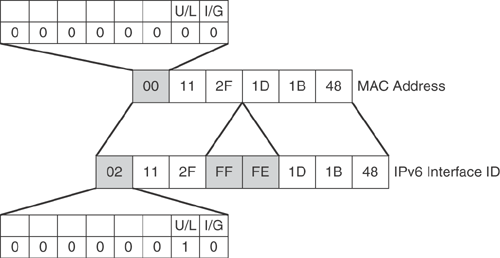Foundation Summary
The Foundation Summary provides a convenient review of many key concepts in this chapter. If you are already comfortable with the topics in this chapter, this summary might help you recall a few details. If you just read this chapter, this review should help solidify some key facts. If you are doing your final prep before the exam, the following lists, tables, and figures are a convenient way to review the day before the exam.
IPv6 provides many important capabilities, including
128-bit addresses, which considerably expands the address space, allowing all users in all countries to have sufficient addresses
Improved support for Mobile IP
Built-in security
Techniques for transitioning from IPv4
Built-in QoS support
Easy autoconfiguration of end-stations
The US Department of Defense plans to have its systems IPv6-compatible by 2008, and many other countries have already started moving to IPv6.
Table 20-2 lists the IPv6 packet header fields, their length in bits, and their use, and indicates comparable IPv4 packet header fields.
| IPv6 Packet Header Field | No. of Bits | Use | Comparable IPv4 Header Field |
|---|---|---|---|
| Version | 4 | IP version | Version |
| Traffic class | 8 | Relative priority | ToS |
| Flow label | 20 | Tagging | (None) |
| Payload length | 16 | Length of data | Total length |
| Next header | 8 | Pointer to extension header or transport-layer header | Protocol |
| Hop limit | 8 | Prevent looping | TTL |
| Source address | 128 | Source of packet | Source address |
| Destination address | 128 | Destination of packet | Destination address |
| Extension headers | (Variable) | Transport layer or optional features | Transport layer header |
Note that fragmentation has been moved to an extension header and is performed by the source node rather than by routers. The IPv4 packet header checksum has been removed.
IPv6 addresses are represented in hexadecimal, with colons between each of the eight 16-bit (4 hexadecimal digit) fields. Two ways to shorten an address are
Omitting leading 0s within a field
Once, and only once, within an address, replacing sequential zeros with a pair of colons (::)
IPv6 supports three types of addresses:
Unicast— The two currently defined types of unicast addresses are global aggregatable unicast (also known as global unicast) and link-local unicast.
Multicast— For sending to all of the interfaces in a group.
Anycast— For sending to the nearest interface in a group.
IPv6 does not have broadcast addresses.
IPv6 interface IDs are always 64-bits long and can be dynamically created, based on the data-link layer address. For Ethernet, the interface ID is based on the MAC address of the interface, in an EUI-64 format. The process of creating an EUI-64 format interface ID is illustrated in Figure 20-8.
Figure 20-8. Creating an EUI-64 Format Interface ID for IPv6 Addresses

IPv6 hosts should support at least the following addresses:
Assigned global unicast and anycast addresses (2000::/3)
Link-local address (FE80::/10), autoconfigured
Loopback address (::1/128)
All-nodes multicast addresses (FF01::1 and FF02::1)
Solicited-nodes multicast addresses (FF02::1:FF00:/104 and appending the last 24 bits of the corresponding unicast or anycast address of the device)
Any other assigned multicast addresses (in the range FF00::/8)
Routers should additionally support at least the following:
Subnet-router anycast address (the unicast address of the subnet, with the interface ID—the host bits—set to zero)
All-routers multicast addresses (FF01::2, FF02::2, and FF05::2)
IPv6 addresses may be manually assigned, or dynamically assigned through DHCPv6 or stateless autoconfiguration.
An IPv6 mobile node has a home address on its home network and a care-of address on its current network. When a mobile node roams away from its home network, it sends a binding update to its home agent, a router on its home network, and to all correspondent nodes.







